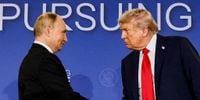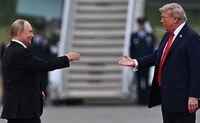Speculation over a potential meeting between U.S. President Donald Trump and Russian President Vladimir Putin has once again captured international attention, as Finnish President Alexander Stubb floated the idea of the two leaders convening at the G20 summit in Johannesburg, South Africa, scheduled for November 21-22, 2025. According to reporting by Yle and Censor.NET, Stubb suggested that such a summit could carry significant political weight, though he offered no further details about the proposal.
Yet, as quickly as the idea surfaced, it appeared to hit a wall of practical and political obstacles. Trump himself had stated as early as August that he would not be traveling to South Africa for the summit, accusing the country's authorities of committing “genocide against the white population.” This claim, which Trump reiterated in April and September, led to the announcement that U.S. Vice President J.D. Vance would represent the United States at the G20 instead. The Kremlin, for its part, was equally dismissive of a face-to-face between the two leaders in Johannesburg. Kremlin spokesperson Dmitry Peskov stated that Putin would not attend the summit in person, though he assured that Russia would be “represented at the summit at an appropriate level.”
This isn’t the first time in recent months that a Trump-Putin meeting has been floated, only to be postponed or canceled. On October 21, 2025, Reuters reported that a planned summit between the two leaders in Budapest had been put on hold, citing the Kremlin’s rejection of an immediate ceasefire in Ukraine. The following day, Trump officially canceled the Budapest meeting, a move confirmed by multiple U.S. media outlets. Later, on October 31, The Financial Times detailed that the cancellation was due to Russia’s refusal to soften its stance on the ongoing war in Ukraine. By early November, the Kremlin publicly stated that there was “no need for a personal meeting” between Putin and Trump to resolve the conflict, further dampening hopes for a diplomatic breakthrough.
President Stubb’s remarks come at a time of heightened security concerns in Finland and across Europe. Addressing his nation’s security environment, Stubb acknowledged its difficulty and emphasized that understanding Russia—its goals and tactics—was central to Finland’s strategic assessment. “By supporting Ukraine, we stand on the same side in many respects,” Stubb said, as reported by Yle. “Understanding Ukraine’s modern military operations gives us a lot.” He reaffirmed Finland’s “clear and strong” support for Ukraine, aligning with much of Europe’s stance since the full-scale Russian invasion began.
The elusive Trump-Putin summit is just one part of a broader diplomatic chess game surrounding the Russia-Ukraine war. On November 3, 2025, President Trump spoke candidly to the press about the prospects for peace. He expressed skepticism that a decisive “final straw” moment would force Putin to end the war, pointing to Russia’s enormous battlefield losses. “There’s no final straw. Sometimes you have to let it fight it out. And they’re fighting and they’re fighting it out. He’s lost a lot of soldiers. Maybe a million. That’s a lot of soldiers. And it’s been tough for Ukraine. It’s been tough on both. Sometimes you have to let it, you know, just get fought out,” Trump said, according to CBS News.
Pressed on the possibility of using economic leverage, Trump explained that his signature tactic of imposing tariffs to end conflicts was ineffective in the case of Russia. “You know how I solved [other conflicts]? I said, in many cases, in 60% I said, ‘If you don’t stop fighting, I’m putting tariffs on both of your countries and you’re not going to be able to do business with the United States’,” he told CBS News. “I did different with him because we don’t do very much business with Russia, for one thing, you know? He’s not, like, somebody that buys a lot from us because of foolishness. And I think he’d like to be. I think he wants to come in and he wants to trade with us, and he wants to make a lotta money for Russia, and I think that’s great.”
Trump’s approach to Putin, as he described it, is less about confrontation and more about openness—at least in rhetoric. When asked about rolling out a “red carpet” for Putin in Alaska, Trump quipped, “I roll out the red carpet for everybody.” He also reminded reporters that the war in Ukraine “came to” him after Joe Biden’s term, insisting that under his presidency, Putin would never have dared to attack Ukraine.
Meanwhile, Ukrainian President Volodymyr Zelenskyy has maintained that every increase in Ukraine’s strength brings the war closer to an end. Zelenskyy credited decisions by Ukraine’s international partners—including the United States—for pushing Russia toward peace. He recently acknowledged “signs of real progress toward peace” but cautioned that an immediate resolution was not guaranteed. Following an October meeting with Trump in Washington, Zelenskyy described their conversation as “very interesting and warm,” and said Trump had conveyed a firm message to both him and Putin: “It’s time to stop the killing and make a deal.”
Diplomatic efforts have not been limited to rhetoric. On November 7, 2025, Trump was scheduled to meet with Zelenskyy at the White House, as the U.S. weighed the possibility of supplying Ukraine with long-range Tomahawk missiles. In a recent social media post, Trump described a call with Putin as “very productive” and announced plans for an initial meeting between U.S. and Russian officials, with Secretary of State Marco Rubio leading the discussions. However, the much-anticipated face-to-face between Trump and Putin in Alaska on August 15, 2025, failed to advance peace negotiations as Trump had hoped.
As the possibility of a Trump-Putin meeting at the G20 fades, the world’s attention remains fixed on the war’s trajectory and the broader fallout. European leaders, such as Germany’s Friedrich Merz, have voiced growing concerns that a global war is no longer a remote prospect, reflecting a sense of unease that extends well beyond the continent. With diplomatic breakthroughs proving elusive and the human cost of the conflict mounting, the international community continues to search for a path toward peace—however uncertain that path may be.






